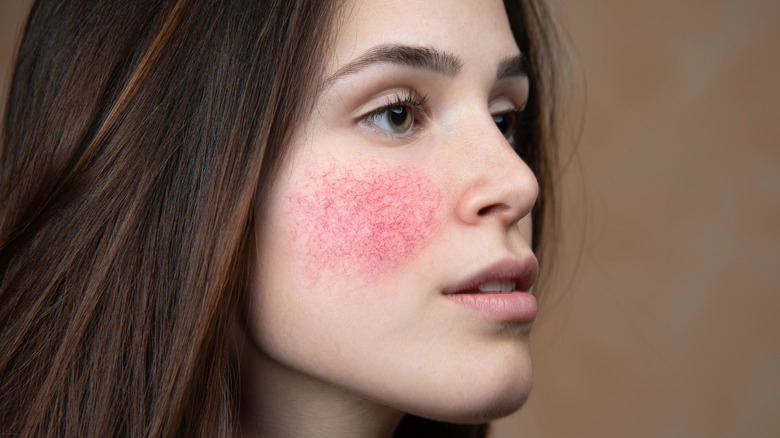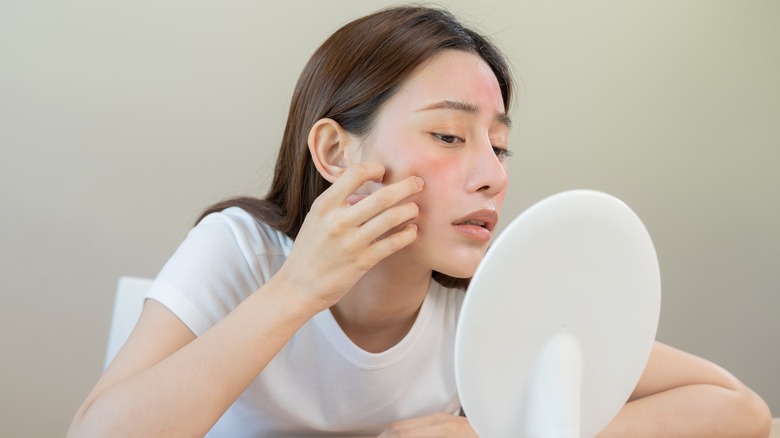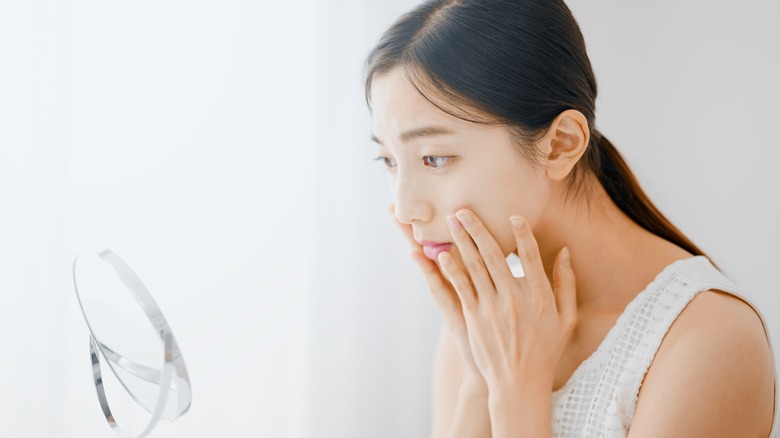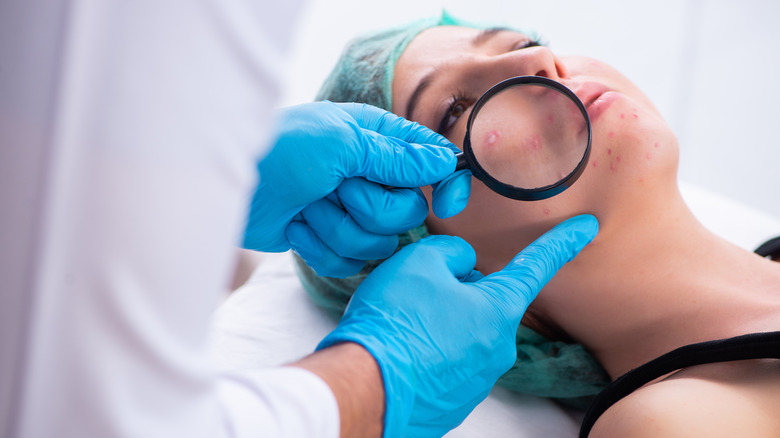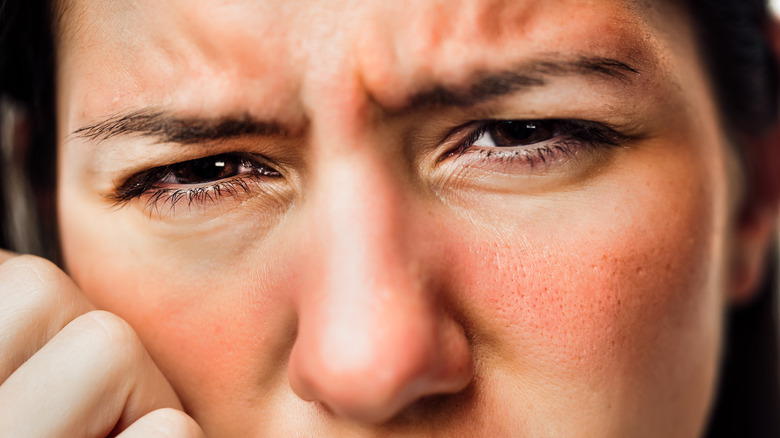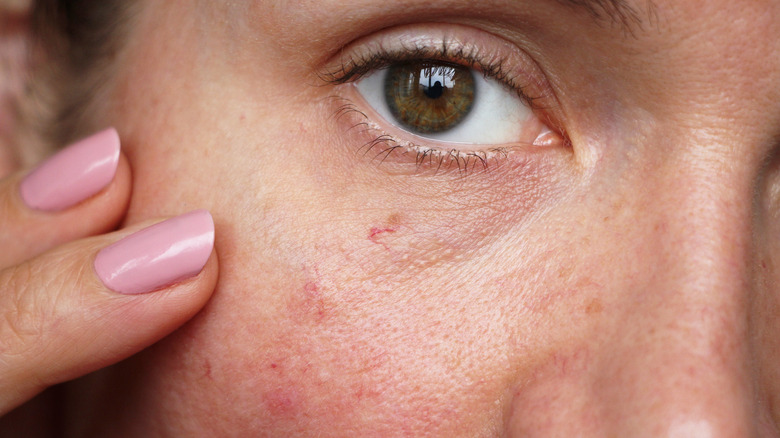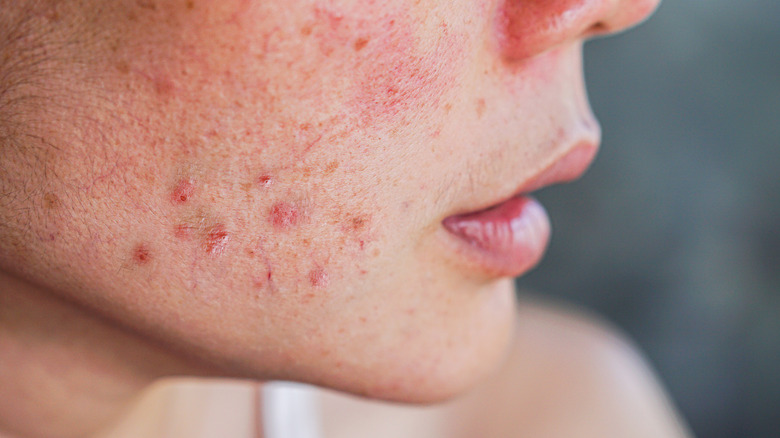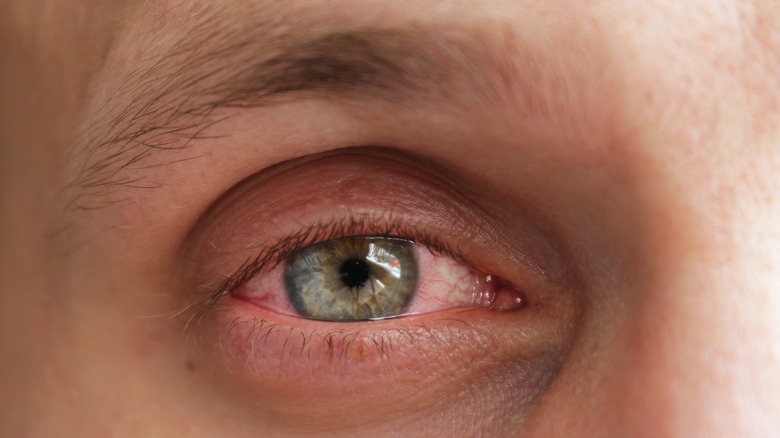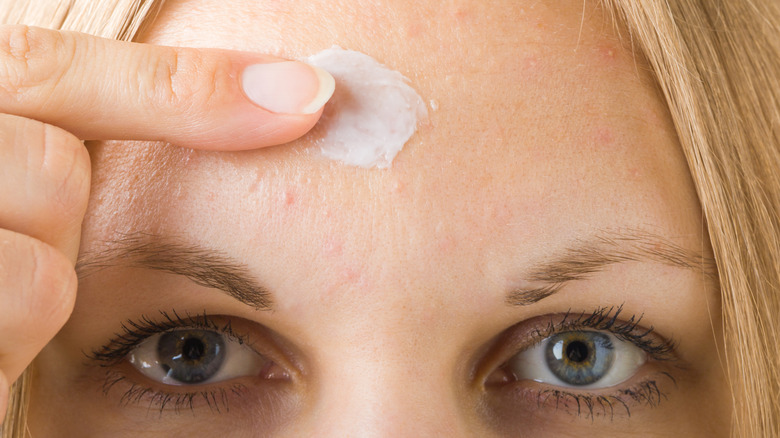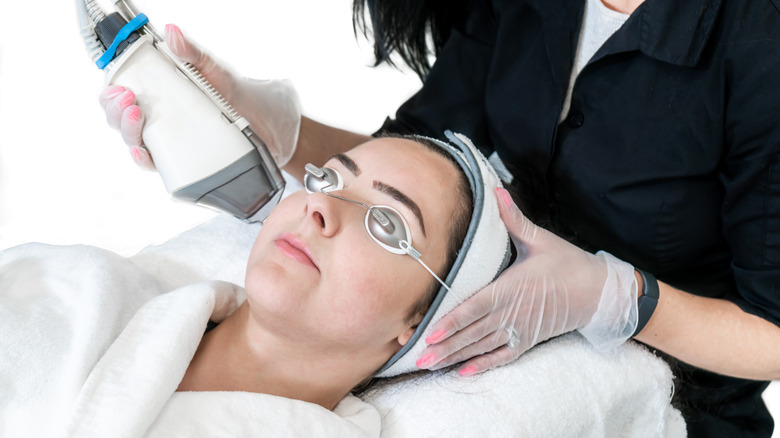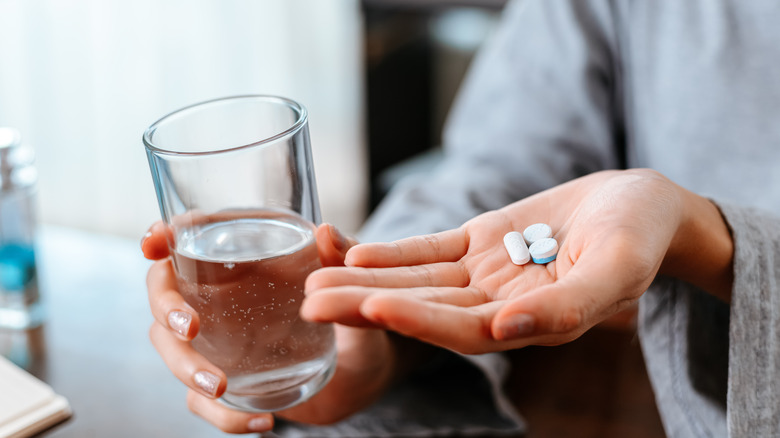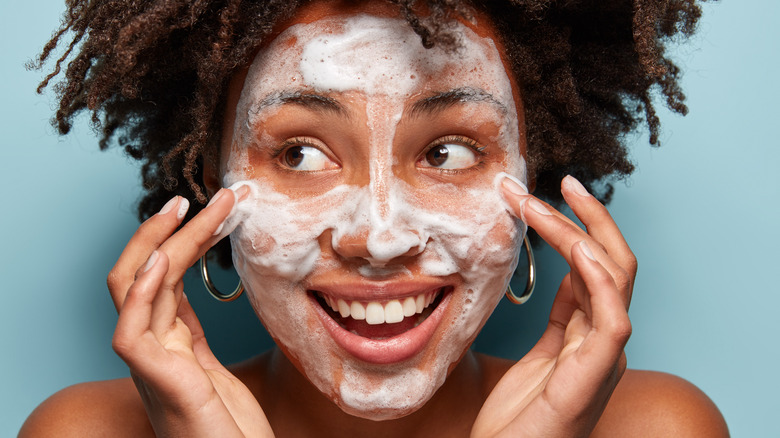Rosacea Explained: Causes, Symptoms, And Treatments
Does your face constantly appear flushed, irritated, bumpy, or rough? If it does, you just might have rosacea. The chronic inflammatory skin disorder affects 16 million Americans and as many as 415 million people worldwide, according to the National Rosacea Society. Unfortunately, the face is the prime target, with the central areas — cheeks, nose, forehead, and eyes — being most affected.
Rosacea has no cure and its diagnosis is based on individual characteristics (called phenotypes). Those attributes include fixed facial reddening (erythema) or skin thickening and irregular surfaces (phymatous), pimples and pustules, flushing, dilated blood vessels (telangiectasia), and ocular issues such as burning and stinging, sties, and bloodshot eyes, reports Premier Research. It's very common for people with rosacea to have a combination of these symptoms.
"Individuals who have rosacea will first start to experience flushing and widespread redness across their cheeks, nose and chin, but as the condition progresses people start to notice dilated blood vessels, pustules and blemishes," Dr. Kemi Fabusiwa, founder of Joyful Skin clinic in the U.K., told Marie Claire. "Over time, if the condition is left unmanaged, it can result in thickened skin, damage to the eyes, and a misshapen, bulbous nose."
Genes play a role
Anyone can get rosacea, but you have a higher likelihood of having the condition if you're a woman of Northern European descent with fair skin, blonde hair, and blue eyes, or if rosacea runs in your family, according to Healthline. Men aren't completely off the hook though, as the Cleveland Clinic explained. While women are more likely to have rosacea, men who get the condition usually suffer more severe symptoms (delays in seeking treatment may be a reason). Both men and women tend to get rosacea after the age of 30. "It usually appears in middle age or later," Dr. Nicholas Perricone, a board-certified dermatologist, confirmed to Everyday Health.
Dr. Soma Mandal, a board-certified internist at Summit Health in Berkeley Heights, New Jersey, told Healthgrades that it's not fully understood why some people get rosacea and others do not. However, some factors, including genetics, are suspected.
Melanin-rich skin also gets rosacea
Rosacea is not just a skin disorder of the fair-skinned. It affects all skin tones and ethnicities, and it's estimated that up to 40 million people of color worldwide have the condition, reports a review in the Journal of the American Academy of Dermatology. Misdiagnosis and delays in proper treatment lead to progressively worse symptoms, unnecessary suffering, and further damage to the skin and eyes.
So why is it still hard to diagnose in the 21st century? Dr. Hao Feng, an assistant professor of dermatology at the University of Connecticut told The New York Times that textbooks used by doctors still don't provide nearly enough images of dermatologic diseases on dark skin. "I can tell you from my own clinical experience a lot of things get missed because people don't recognize the disease process in darker skin," he explained.
Pattern recognition is integral to recognizing certain disorders. Skin conditions may be more nuanced on brown or black skin, appearing purple or dusky brown instead of bright red, Dr. Valerie Harvey, a dermatologist and the president-elect of the Skin of Color Society, told Everyday Health. Dr. Nada Elbuluk, a board-certified dermatologist in Los Angeles, told Allure, "Melanin in the skin tends to mask the redness, which we medically call erythema." Elbuluk continued, saying, "It's a more subtle presentation."
Your immune system is overreacting
One thing rosacea may be linked to, according to research, is the overproduction of cathelicidin. It's an antimicrobial protein-peptide the body uses to prevent infections, as explained by The Washington Post. When the immune system releases too much of it, cathelicidin can trigger autoimmune-like diseases such as rosacea.
"[For those with rosacea] their innate immune system is sort of tuned to hot — it's oversensitive, so it's going off when it shouldn't go off," dermatologist and microbiologist Dr. Richard Gallo, founding chairman of the department of dermatology at the University of California at San Diego, told The Washington Post.
Additionally, research has shown that the immune systems of most people with "acne-like rosacea" are triggered by a bacterium called bacillus oleronius, according to the American Academy of Dermatology Association. "This reaction causes their immune system to overreact," the association explained. "Scientists still do not know whether this can cause rosacea."
Your gut bacteria may be imbalanced
A study published in the American Journal of Gastroenterology revealed that your gut flora may be connected to rosacea and inflammatory acne — and probiotics is a likely key to treatment.
It all has to do with the gastrointestinal tract and the organisms living in it, known as the microbiome. Though it may sound gross, you have something like 300 to 500 different species of bacteria living in your digestive tract. But don't worry — when everything's humming along, these organisms help keep your system in good shape. The trouble happens when your gut bacteria is out of whack. Several trials have demonstrated that the relationship between your microbiome and skin is important and they "may offer defense against pathogens in the environment," according to Dermatology Times.
New York-based dermatologist Dr. Michele Farber told Allure, "Probiotics like lactobacillus and bifidobacterium have been shown to reduce systemic inflammation and improve rosacea. Prebiotics encourage the growth of healthy bacteria on the skin."
Skin mites may be partially to blame
Mites on your skin? It has the "ick" factor for sure, but the fact is that we all have these microscopic creatures living on our skin. Oh, yes, it's true!
You can't see them with the naked eye — and about five of them stretched end to end would barely cover the head of a pin (via NPR). Their proper names are Demodex folliculorum and Demodex brevis, and these mites live inside your hair follicles where they feast on the waxy natural oils on your skin, called sebum. Everyone has face mites, and as disgusting as they may sound you can't scrub them off.
"Some studies have shown an increased number of Demodex folliculorum mites in patients with rosacea, and it's thought that either the mites or bacteria living on the mites could trigger rosacea," says Los Angeles-based cosmetic dermatologist Jessica Wu told Everyday Health. "But the overgrowth could be a result of inflammation and increased oil production, rather than the underlying cause."
Your skin may flush frequently or look sunburned
Facial redness that looks like you're flushed or blushing, especially on the cheeks and nose, is the hallmark of rosacea on fair skin. "Rosacea is an inflammatory condition when facial blood vessels dilate too easily, and the increased blood near the skin surface makes the skin appear red and flushed," Dr. Howard Murad, a dermatologist and assistant clinical professor of dermatology at the University of California at Los Angeles, told Everyday Health.
According to the Cleveland Clinic, people with rosacea often report experiencing frequent flushing. The facial redness, which might come and go, often is the earliest sign of the disorder," the clinic explained. If the facial redness sticks around instead of coming and going, it may look more like sunburn.
If you suspect you may have rosacea, don't ignore it. The condition can get progressively more severe. The occasional flushing that starts out as just an annoyance, warns Prevention, could become a much bigger issue that includes itchy bumps and pustules across your face.
Spider veins are a common symptom
If you have rosacea, you may notice clusters of broken blood vessels on your skin radiating outward like branches. These patterns are called telangiectasias, or spider veins, according to Medical News Today. Lots of people have a few of these harmless blood vessels on the sides of their nose and other areas of the body. With rosacea, telangiectasias can look especially prominent on your cheeks or eyelids.
"Studies have shown that those with rosacea have abnormally high levels of a peptide (protein fragment) called cathelicidin in their bloodstream. ... These peptides trigger the formation of new blood vessels (leading to redness and spider veins) as well as inflammation (leading to pimples, bumps, and breakouts)," Dr. Jessica Wu, a cosmetic dermatologist, told Everyday Health.
Many things can make blood vessels appear more prominent, such as lots of sun exposure and heat, drinking alcohol, and eating spicy foods (via Medical News Today).
Papulopustular rosacea
Pimples and pustules are common symptoms of papulopustular rosacea (aka acne rosacea), according to NYU Langone Health. With this type of rosacea, you'll still have flushed and sensitive skin as you would with erythematotelangiectatic rosacea– formerly called subtype 1 — but your cheeks, chin, and maybe even your forehead will experience whiteheads and small red bumps that look similar to acne (via Premier Research).
"Many patients experience no symptoms [with acne rosacea], but oftentimes patients feel their skin flushes, is hot, itchy or feels more sensitive," dermatologist Rachel Nazarian of Schweiger Dermatology Group in New York City, told Allure. "Over time, with repeated flares, the face may appear more consistently puffy and red."
According to a 2020 review in the Journal of Dermatology and Therapy that summarized advances in treatment therapies, an anti-inflammatory and anti-parasitic agent has shown success. "Topical ivermectin was demonstrated to be the most effective topical treatment for papulopustular rosacea and to provide the greatest psychological benefit to these patients," the review explained.
Ocular rosacea
If you have a burning, itchy, and gritty feeling in your eyes, you probably just think you have allergies — and in many cases, you'd be correct. However, ocular rosacea could also be a cause, even without the classic symptoms on the rest of the face.
When rosacea affects the eyes, your eyelids will look red and puffy and your eyes will probably feel sensitive to light. In addition to your discomfort, a more serious aspect of the condition is damage to your cornea if your eyes dry out too much from the evaporation of tears. An ophthalmologist can provide a diagnosis by using a microscope to zoom in on the blood vessels and glands, as well as conducting a test to check your tear function (via Healthline). Steroid eye drops will help bring down the redness and swelling, and antibiotics may also be useful to treat the infection, according to the American Academy of Ophthalmology.
"There is no cure for ocular rosacea, but medications can help control the symptoms," explained Medical News Today. "It is important to work with a doctor to manage the condition, as ocular rosacea can cause vision changes if it is severe and left untreated."
An array of topicals can help treat the condition
As challenging as rosacea can be to treat, many topical prescription drugs are at the ready to help tamp down outbreaks (via Mayo Clinic). Vasoconstrictors such as brimonidine and oxymetazoline will constrict visible blood vessels to lessen redness. Acids and antibiotic creams and gels like azelaic acid and metronidazole will decrease swelling and redness from pimples.
Ivermectin, an anti-inflammatory and anti-parasitic drug, works to target the pimples, pustules, redness, and Demodex mites. "Sometimes, applying a prescription topical anti-mite cream can help manage acne rosacea symptoms," Dr. Tsippora Shainhouse, a Los Angeles board-certified dermatologist, told Everyday Health.
Dr. Hilary Baldwin, medical director of the Acne Treatment and Research Center in Brooklyn, New York, told Dermatology Times, "With a combination of medications, most rosacea patients can be brought to a reasonable level of disease, if not clear." She explained, "Sometimes you have to move beyond the FDA-approved therapies, including isotretinoin and prednisone."
Laser or electrosurgery treatments work well
Among the more expensive treatments for rosacea is laser therapy. You'll almost always need multiple treatments and depending on the laser, you may want to plan some downtime. Lasers can be highly effective to target the redness of rosacea by attacking the visible broken vessels on the face. Common therapies are the C02 laser, pulsed dye laser, and YAG laser, as well as intense pulsed light therapy, which is not technically a laser but it uses light to achieve similar results (via Mayo Clinic). "Laser treatment isn't a cure for rosacea, but many patients see results for months or even years after treatment," Dr. Sanusi Umar, a board-certified dermatologist in California, told Healthgrades.
Electrosurgery achieves a similar outcome with reducing redness but in a different way. Instead of aiming a focused beam of light, "a dermatologist uses a thin needle to apply a weak electrical current directly to [the] blood vessels, causing them to clot and shrink," NYU Langone Health noted.
Your doctor may prescribe oral antibiotics
Low-dose oral antibiotics in the tetracycline class are a tried-and-true option for reducing redness and clearing blemishes when topical prescription creams and gels have not been effective. "These nonantibiotic doses of a tetracycline, such as doxycycline, can be used as long-term rosacea treatment without heightening your risk of developing a resistance to antibiotics," NYU Langone Health explained.
Taken orally, sarecycline may work well for papulopustular or inflammatory rosacea, which is the type that features red bumps and pus-filled blemishes, as was demonstrated in a 2021 study published in the Journal of Drugs in Dermatology. This tetracycline-class antibiotic has been FDA-approved for acne since 2018 and has a low risk of side effects.
Nevertheless, one medication may not be enough. "When the patient has combination rosacea, you always need multiple medications or procedures," Dr. Hilary Baldwin, medical director of the Acne Treatment and Research Center, told Dermatology Times. "You will need at least 2 pharmacologic/procedural techniques to make that patient well," she added.
Reduce flare-ups by avoiding triggers
Give up your red wine? Say it isn't so! It might just be what it takes if alcohol is a trigger to your rosacea. Red wine tops the list of alcoholic drinks that bring on flares, warns the National Rosacea Society. And one glass — or even just a couple of sips — is sometimes all it takes.
Alcohol isn't the only trigger, though. "Possible rosacea triggers include sunlight, heat or extreme temperature, wind, exercise, caffeine, spicy food, stress, alcohol, medications such as steroids, or other irritating topical products," Dr. Nianda Reid, a board-certified dermatologist in Pennsylvania, told Prevention.
Being in a heightened state of stress is another trigger, as it is for many other conditions. "Emotional stress can lead to an increase in inflammatory mediators and greater circulation to the face, causing redness and flushing," medical and cosmetic dermatologist Anjali Mahto told Harper's Bazaar.
It may seem there's no rhyme or reason why some activities, foods, or situations activate rosacea, and just because something's been identified doesn't mean it'll apply to you. "Rarely is everyone [set off] by everything on the list," dermatologist Charles E. Crutchfield III told Everyday Health. And even if your condition is sensitive to a particular thing, you may still be able to make allowances. "I have several patients who say that on New Year's Eve or on their birthday, they're going to have a glass of champagne," Crutchfield revealed. "It's a risk that at times they're willing to accept."
Take it back to basics
Fundamentals like keeping your skin clean and moisturized will do a world of good for rosacea, according to the experts. A great place to start is choosing mild cleansers, moisturizers, and high-SPF sunscreen, as well as avoiding drying alcohol-based products.
"Basic skin care alone can improve rosacea symptoms," Dr. Emmy Graber, a board-certified dermatologist and founder of the Dermatology Institute of Boston, confirmed to Dermatology Times. "I tell my patients to check all their products for anything on them that says alpha-hydroxy acids. These are the things we want our patients to avoid because it exacerbates their rosacea."
Rosacea can be effectively managed and kept under control if you're persistent and stick with a treatment plan customized for you by a skincare professional. "Management of rosacea takes routine and perseverance," Dr. Alexis Granite, a medical and aesthetic dermatologist in London, told Harper's Bazaar, "but improvement is absolutely possible."

